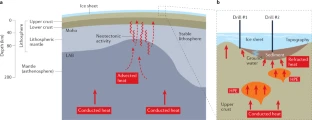Phys.org December 13, 2022
Geothermal heat flow (GHF) can reveal past and present plate tectonic processes. In Antarctica, GHF has further consequences in predicting the response of ice sheets to climate change. In a review article an international team of researchers (Australia, Germany, USA – Stony Brook University, Colorado College) discuss variations in Antarctic GHF models based on geophysical methods and draw insights into tectonics and GHF model usage for ice sheet modelling. The inferred GHF at continental scale for West Antarctica points to numerous contributing influences, including non-steady state neotectonic processes. Combined influences cause especially high values in the vicinity of the Thwaites Glacier, a location critical for the accurate prediction of accelerated loss of Antarctic ice mass. The inferred variations across East Antarctica are more subtle where slightly elevated values in some locations correspond to the influence of thinned lithosphere and tectonic units with concentrations of heat-producing elements. Fine-scale anomalies owing to heat-producing elements and horizontal components of heat flow are important for regional modelling. GHF maps comprising central values with these fine-scale anomalies captured within uncertainty bounds can thus enable improved ensemble-based ice sheet model predictions of Antarctic ice loss…read more. TECHNICAL ARTICLE

Multiple contributors to geothermal heat flow. Credit: Nature Reviews Earth & Environment volume 3, pages814–831 2022